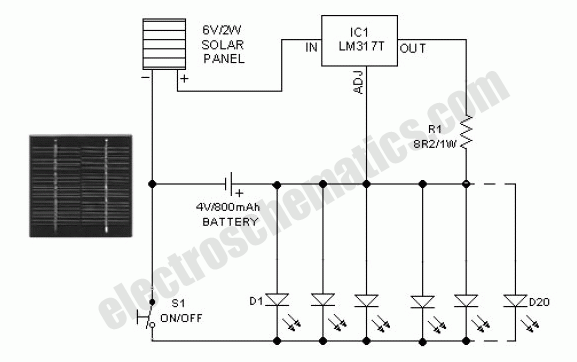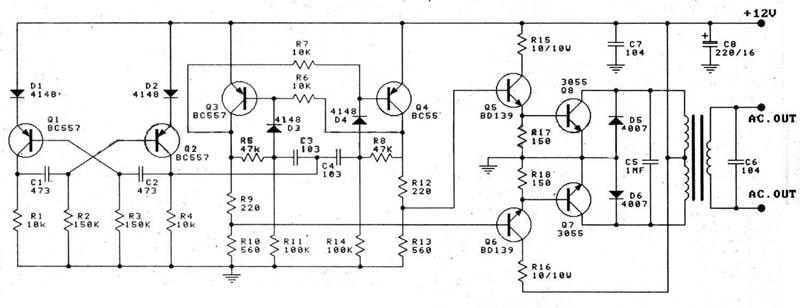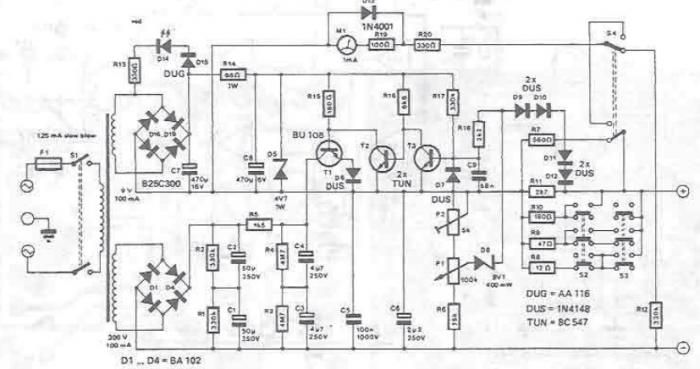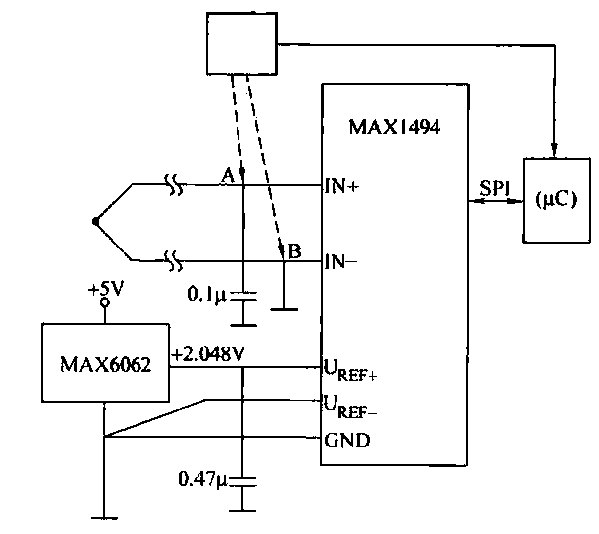
Camera flash circuit
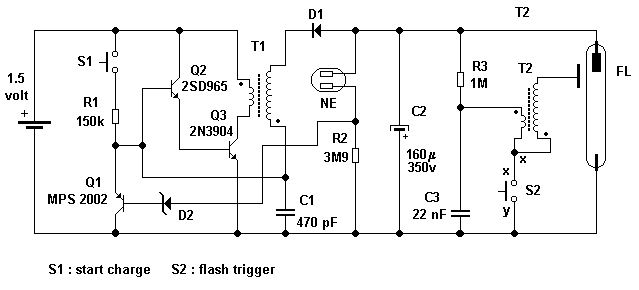
A simple transistor generator and transformer converts a 1.5V battery voltage to several hundred volts. This high voltage current then passes through a diode, which rectifies the current to DC. This DC current is stored in a relatively large capacitor. The capacitor is continuously connected to two electrodes on the flash tube; however, the tube cannot conduct current until the xenon gas is ionized, preventing the capacitor from discharging and the tube from flashing. The capacitor is also linked to a small gas discharge tube via a resistor. When the voltage in the capacitor reaches a sufficient level, the small tube lights up, serving as an indicator that the flash is ready. When the camera trigger is pressed, it briefly closes the circuit, connecting the capacitor to a second transformer. This transformer elevates the 290-volt current from the storage capacitor to between 1,000 and 10,000 volts, sending a high-voltage pulse to a metal plate adjacent to the flash tube. This momentary high voltage energizes the xenon gas, making it conductive and allowing the flash tube to discharge.
The circuit begins with a low-voltage power source, a 1.5V battery, which feeds into a transistor-based oscillator circuit. This oscillator drives a transformer that steps up the voltage significantly to several hundred volts. The output from the transformer is AC voltage, which is then rectified by a diode to convert it to direct current (DC). The rectified DC voltage is stored in a large capacitor, which is crucial for providing the necessary energy for the flash operation.
The capacitor is connected to the electrodes of a flash tube but remains inactive until the xenon gas within the tube is ionized. The ionization occurs when the voltage across the capacitor builds up sufficiently, which is indicated by a small gas discharge tube connected through a resistor. This tube glows when the voltage is adequate, signaling readiness for the flash.
Upon pressing the camera trigger, a switch momentarily connects the charged capacitor to a second transformer designed to further amplify the voltage. This transformer takes the 290 volts stored in the capacitor and boosts it to a range between 1,000 and 10,000 volts. The high-voltage pulse is directed to a metal plate positioned near the flash tube. The sudden surge in voltage causes the xenon gas to ionize, transforming it into a conductive state. This ionization allows the stored energy in the capacitor to discharge rapidly through the flash tube, producing a bright flash of light.
This circuit design effectively demonstrates the principles of voltage transformation, energy storage, and gas ionization, making it suitable for applications in photography and other fields requiring high-intensity light bursts. Proper safety measures should be taken when working with high voltages to prevent electrical hazards.Simple few transistors generator and transformer A transforms 1. 5V battery voltage to few hundred of volts. This is quite high voltage. Then this high-voltage current passes through a diode, which rectifies current to DC. This DC current is stored in quite big capacitor. The capacitor is connected to the two electrodes on the flash tube at all tim es, but unless the xenon gas is ionized, the tube can`t conduct the current, so the capacitor can`t discharge and tube didn`t flash. The capacitor is also connected to a small gas discharge tube via a resistor. When the voltage in the capacitor is high enough, the small tube lights up. This acts as an indicator light, telling you when the flash is ready for action. When you press trigger of camera, the trigger closes briefly, connecting the capacitor to a second transformer.
This transformer boosts the 290-volt current from the storage capacitor up to between 1, 000 and 10, 000 volts, and passes the high-voltage current pulse onto the metal plate next to the flash tube. The momentary high voltage on the metal plate provides the necessary energy to ionize the xenon gas, making the gas conductive.
And the flash tube discharge. 🔗 External reference
The circuit begins with a low-voltage power source, a 1.5V battery, which feeds into a transistor-based oscillator circuit. This oscillator drives a transformer that steps up the voltage significantly to several hundred volts. The output from the transformer is AC voltage, which is then rectified by a diode to convert it to direct current (DC). The rectified DC voltage is stored in a large capacitor, which is crucial for providing the necessary energy for the flash operation.
The capacitor is connected to the electrodes of a flash tube but remains inactive until the xenon gas within the tube is ionized. The ionization occurs when the voltage across the capacitor builds up sufficiently, which is indicated by a small gas discharge tube connected through a resistor. This tube glows when the voltage is adequate, signaling readiness for the flash.
Upon pressing the camera trigger, a switch momentarily connects the charged capacitor to a second transformer designed to further amplify the voltage. This transformer takes the 290 volts stored in the capacitor and boosts it to a range between 1,000 and 10,000 volts. The high-voltage pulse is directed to a metal plate positioned near the flash tube. The sudden surge in voltage causes the xenon gas to ionize, transforming it into a conductive state. This ionization allows the stored energy in the capacitor to discharge rapidly through the flash tube, producing a bright flash of light.
This circuit design effectively demonstrates the principles of voltage transformation, energy storage, and gas ionization, making it suitable for applications in photography and other fields requiring high-intensity light bursts. Proper safety measures should be taken when working with high voltages to prevent electrical hazards.Simple few transistors generator and transformer A transforms 1. 5V battery voltage to few hundred of volts. This is quite high voltage. Then this high-voltage current passes through a diode, which rectifies current to DC. This DC current is stored in quite big capacitor. The capacitor is connected to the two electrodes on the flash tube at all tim es, but unless the xenon gas is ionized, the tube can`t conduct the current, so the capacitor can`t discharge and tube didn`t flash. The capacitor is also connected to a small gas discharge tube via a resistor. When the voltage in the capacitor is high enough, the small tube lights up. This acts as an indicator light, telling you when the flash is ready for action. When you press trigger of camera, the trigger closes briefly, connecting the capacitor to a second transformer.
This transformer boosts the 290-volt current from the storage capacitor up to between 1, 000 and 10, 000 volts, and passes the high-voltage current pulse onto the metal plate next to the flash tube. The momentary high voltage on the metal plate provides the necessary energy to ionize the xenon gas, making the gas conductive.
And the flash tube discharge. 🔗 External reference

